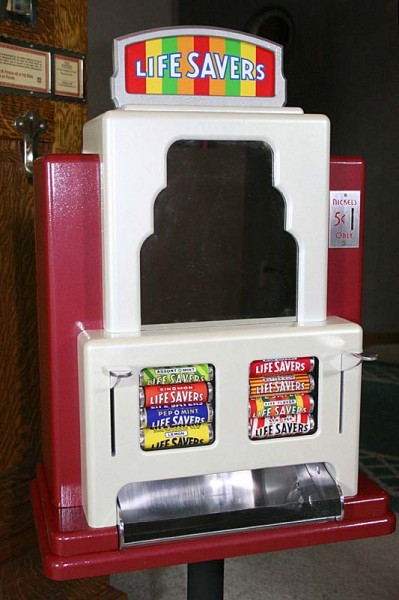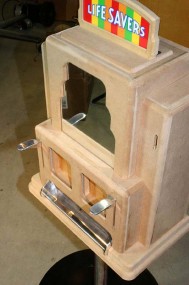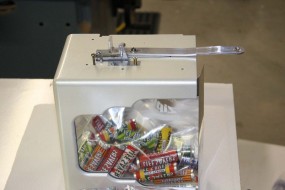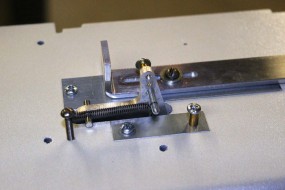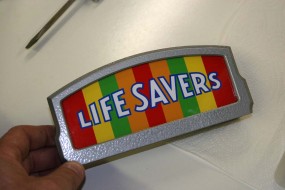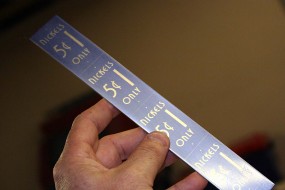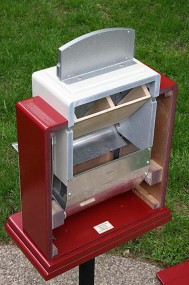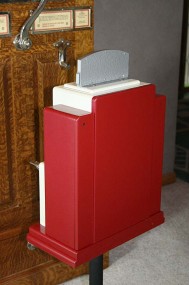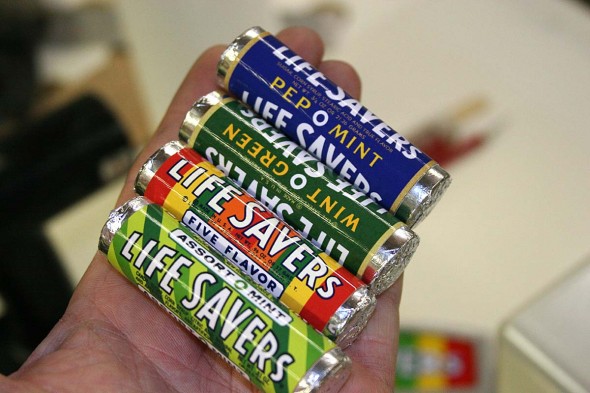Building a Theatrical Prop Candy Machine
An Original Design Inspired by ’40s-’50s Stoner Vending Machines
This was a fun little side project that came out of nowhere.
I was approached to help with development of a working prop for a stage play that was in the works for a Minneapolis theater. The prop needed to be a candy machine, specifically a Lifesaver vending machine that would be rigged to hit the jackpot and spill at least twenty lifesaver rolls out on the floor when a lever was pressed. It also had to take a coin, but that did not need to be part of the functional mechanism. There was no requirement that the prop look authentic; it just had to be recognizable as a candy machine.
The play was based on a story set in a department store the 1960s, so there was a real opportunity to make something more decorative than a simple box vending machine of later decades. I had been handed a few functional requirements and tentative dimensions, but I was already fixated on the idea of making something in the deco style of a vintage Stoner candy machine, some versions of which vended both candy bars and roll candy.
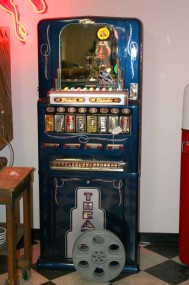
Vintage Candy Machine Made by Stoner
The one and only movie theater that I attended in my youth had an illuminated Stoner Theater model candy machine in the curved walkway that connected the seating areas, and at the time I was drawn to mechanical things of all types. In the end the design that came together for this project represents somewhat of a composite machine that never existed, but one that I would be drawn to as a collector if I saw it at a sale or a show.
Armed with the basic requirements, I started work and made some quick progress in the first couple of days. A simple design was worked out and had about a third of the woodwork done when I was reminded that at least one of the size constraints was serious…
The theater where the play was to be presented is without a traditional open-front stage; the presentations are held in-the-round with the audience seated on all sides and the actors performing in the center. This required that the candy machine be limited in height to 38″ or less. It could not block the view of any portion of the audience that might be seated behind it. This was not going to work with a full-size prop, and I had to start over on something that could be that short and still look plausible. The cabinet I was working on was aborted.
Small stand-mounted gum and vending machines typically fall somewhere in this size and height range, and I came up with a scaled-down design that would function as needed but still be visually interesting and believable. Equally important was the need to be able to put something together in a short time, since I was brought into this project a little late.
The case for the machine was made from 1/2″ and 3/4″ medium density fiberboard (MDF). This is a not a favorite material to work with, but it is stable, and you can machine, finish, and paint it such that it can look almost like sheet or cast metal. Some of the parts would be painted different colors, so everything was made to be assembled with machine screws after painting.
The mirror was a carryover from the Stoner machine, and I had some BS story concocted about why it would still be plausible on a machine of this height. It was a bit low for checking hair or makeup but perhaps still useful for checking fly status.
The mechanism was simple but it had to be foolproof. I wasn’t going to be attending the play, but even so I didn’t want anyone to have to deal with a failure during performance. It was made of a combination of aluminum and steel parts, some formed and some machined. At the last minute I added a ratcheting feature – common in nearly all mechanical vendors – that forces the hand lever to complete a full cycle downward before returning to the upright position.
A curved aluminum ramp was located under the drop-down tray and extended to the bottom front. This was made of thin metal so that it would make plenty of noise when the rolls dropped. Unlike a real tray, the metal had no dip in the bottom where the candy would be retained; the slope forced everything to fly out the front. This is not immediately apparent unless you are looking for it.
A removable marquee and cover rests on top of the machine to allow access for loading. To load, a drop-down tray in the top is pulled upward and latched and the tray is filled with two rows of ten candy rolls. When the rightmost aluminum lever on the front is pressed, the tray drops, dumping all of the contents on the floor.
The prop didn’t really have to do much, but even the simplest designs don’t always work as expected the first time. On first tests of the mockup, using wood dowels as dummy lifesaver rolls, the drop-down tray latching and release was positive. But unfortunately about one in ten dumps would result in a log jam at the opening tray, and this was too unreliable. Different metal ramp profiles didn’t help, so the tray opening height had to be increased. I didn’t want to remake everything, so I added another 3/4″ tier to the base, and this fixed the problem. I actually like the way it turned out, and I think it looks better than the original single-thickness base. Sometimes, rarely, mistakes end up resulting in a better design, but more often they result in rework. This was a good mistake.
After everything was tested out, the MDF parts were primed with a shellac-based filler and painted with hammertone colors. An aluminum coin entry plate was designed in Illustrator and photo etched to allow the letters to take paint. A stand was made from a pipe with a plate welded on top, and then mounted to a 17″ diameter disc harrow blade purchased from a farm equipment store.
Off and on during the project (usually while paint was drying) I would chip away at the task of making some dummy candy rolls. Apparently you can still order Lifesavers in roll packages (as opposed to bags around here), but based on my sample of one package of real candy that I stole from one of my vendor slot machines, it didn’t look like they would hold up well to too many floor impacts. The dummy rolls were made by covering 3/4″ dowels with foil and using printed labels from images found on the web (thanks to whoever spent the time creating that artwork).
Happily the prop worked without incident throughout the play’s run, and it now is on display in my theater room alongside some genuine vintage vending and slot machines.
![]()

